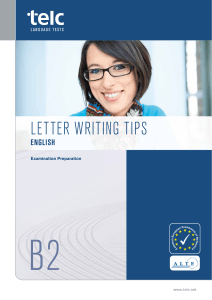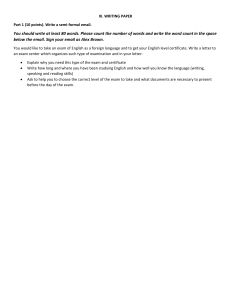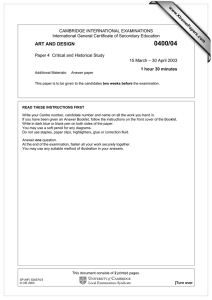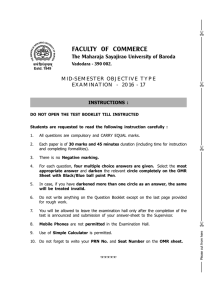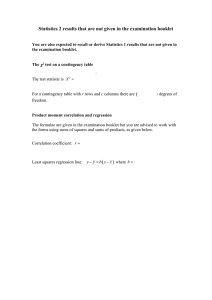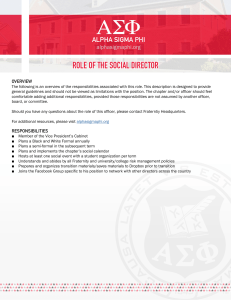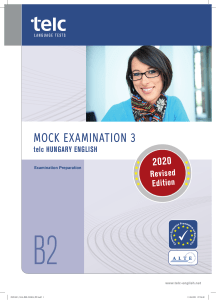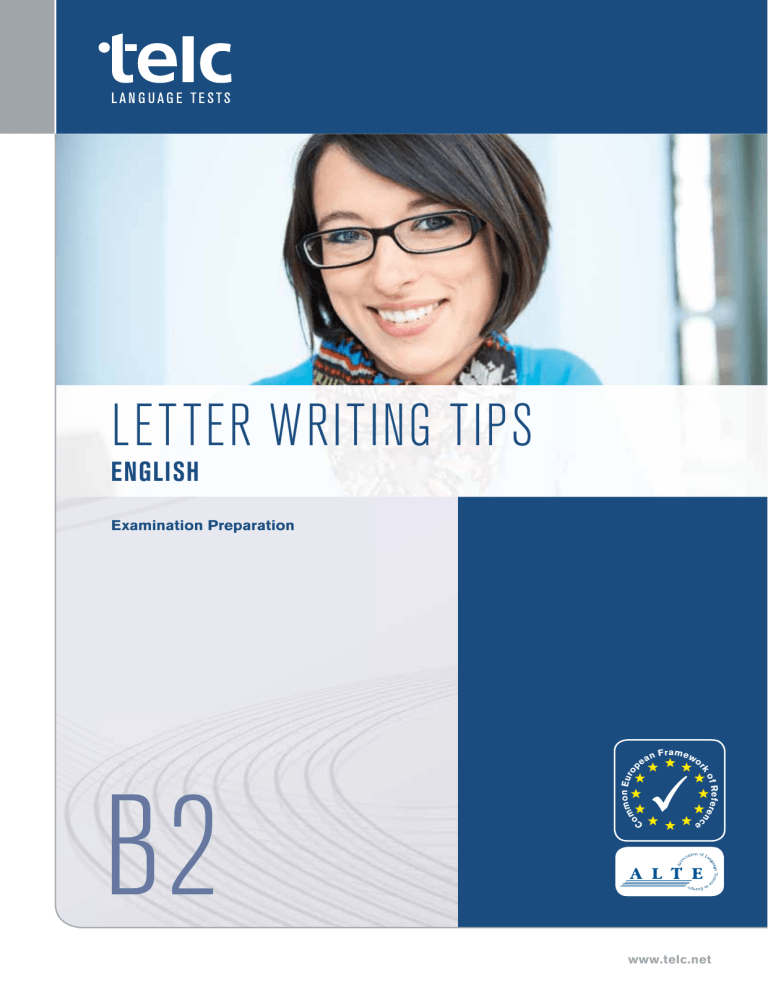
LETTER WRITING TIPS ENGLISH Examination Preparation p of R m o n E ur o n F r a m e wo rk nc om efere e C B2 ea www.telc.net 4 Contents Introduction 5 Ef fective semi-formal letters The parts of a semi-formal letter 6 The five most common letter writing errors 9 Stock phrases 13 The telc writing task Before you start writing 15 Writing at level B2 16 The telc marking criteria 17 Assessing your work 36 Answer key 46 L e t t e r W r i t i n g T i p s t e l c E n g l i s h B2 5 Introduction Introduction Dear Reader, If you are preparing for the telc English B2 examination, read on! With the help of this booklet, you will be able to improve your writing skills and achieve better overall results in this important examination. Who is “Letter Writing Tips” for? This booklet has been written for learners preparing for the telc English B2 examination. How should you use this booklet? Ideally, you should work through the following pages with the teacher who is preparing you for the telc English B2 examination. During your preparation course, your teacher will identify those areas where you need to improve. The exercises in this booklet can then be supplemented by further activities. “Letter Writing Tips”, however, is also suitable for self-study. What does this booklet contain? There are two parts. Part 1 covers general issues of writing semi-formal letters, such as layout, content and style. Part 2 is specifically about the writing task of the telc English B2 examination. Here you will be given tips on how best to fulfill the writing task and what exactly the raters are looking for in a B2 letter. A description of the marking criteria, sample exercises and suggested solutions complete this part of the booklet. What kind of exercises are included? There are two categories of activities: Exercises which specifically look at letter writing skills. Exercises that focus on relevant grammar topics, vocabulary, etc. Suggested solutions to these exercises can be found in the answer key. Please remember that these activities are only a selection of the potential problem areas in letter writing that have been identified by raters recently. Naturally, the exercises do not cover all aspects of general grammar or writing. Ask your teacher for more activities if you feel you need more practice. We wish you all the best for your telc English B2 examination. Your telc team L e t t e r W r i t i n g T i p s t e l c E n g l i s h B2 6 Effective semi-formal letters Effective semi-formal letters The parts of a semi-formal letter A semi-formal letter is a letter that you write to someone you do not know on a personal level. You may have to write this type of letter for a variety of reasons; for example, to ask for more information, to make a complaint or to apply for a job. Please note: There are some differences in layout between British English and American English and according to personal preferences. In this booklet, we will introduce some of the most frequently found formats. For examination purposes, we recommend that you choose one of the formats introduced in this booklet. A formal or semi-formal letter consists of the following parts: 1 Addresses (sender’s address and recipient’s address) Write your name and address either in the top right-hand corner of the page or in the top lefthand corner. The recipient’s name, (job title, company name) and address should be placed on the left, starting below your address. 2 Date The date is usually written in one of two ways: 24 March 2013 (begin with the day; no comma) or March 24, 2013 (begin with the month; comma). It is common to write the month out as a word. Put the date under your address or beneath the recipient’s address. 3 Salutation or greeting If you are writing to a person whose name and gender you do not know, use “Dear Sir or Madam”. If you know the person’s name, use the title (Mr or Ms) and the surname (e.g. Dear Mr Goodwin). If you are writing to a woman, it is common to use Ms, which is for both married and single women (e.g. Dear Ms Richardson). Abbreviations like “Mr” or “Ms” can be used with or without a full stop (“Mr.” or “Mr”), but be consistent throughout your letter. If you decide to write “Mr.” with a full stop, always write it with a full stop in your letter. Some people use a comma after the salutation (Dear Mr. Goodwin,) while others prefer a colon (Dear Mr. Goodwin:) The latest development is not to use any punctuation (Dear Mr. Goodwin). Informal greetings such as “Hi,” “Hello,” or “Hey there” are fine for personal letters to friends and family but should not be used in official letters. L e t t e r W r i t i n g T i p s t e l c E n g l i s h B2 9 Effective semi-formal letters The five most common letter writing errors Even if you include all seven parts in your letter, there are still a few other things that you should keep in mind. Here is a list of the most common letter writing errors and some general tips on how to avoid them. More tips and details will follow in the second section of this booklet. Using inappropriate language Problem Tips If you use inappropriate language, your letter will easily sound impersonal, disrespectful or rude. $YRLGLQIRUPDOODQJXDJHDQGVODQJ % HIULHQGO\DQGSROLWHHYHQLI\RXDUH complaining. $YRLGODQJXDJHWKDWLVWRRIRUPDO Using too many repetitions Problem Tips If you continually repeat the same words or phrases, your letter becomes boring and difficult to read. $GGYDULHW\WR\RXUODQJXDJH ' RQRWVWDUWHYHU\VHQWHQFHZLWKWKHVDPH word. $YRLGXVLQJSHWSKUDVHV 'RQRWXVHWKHZRUG´,µWRRPXFK Not saying enough Problem If you do not provide enough information, your reader may misunderstand your message. Tips 'RQRWIRUJHWWRVD\ZK\\RXDUHZULWLQJ 6 XSSRUW\RXUSRLQWVZLWKUHOHYDQWGHWDLOV and/or examples. 3 XW\RXUVHOILQWKHUHFLSLHQW·VSODFH+RZ would he/she react when reading this letter? ' RQRWRYHUXVHYDJXHZRUGV HJYHU\QLFH really, good, etc.). L e t t e r W r i t i n g T i p s t e l c E n g l i s h B2 11 Effective semi-formal letters Activity 1 Work in pairs or small groups. Read the letter below and discuss what works well and what could be improved. Here are some questions to help you: 3 3 3 3 Does the letter consist of the seven parts mentioned above? Are the salutation and complimentary closing appropriate for a semi-formal letter? Does the letter begin with a strong opening sentence? Is it always clear what the writer wants to say? Katalin Bródy Hársfa u. 39 1074 Budapest Hungary Ms. Mary Richardson Host Family Coordinator Parkland Summer School 32 Charlotte Street London W1T 2NH Dear Ms. Richardson, I am writing to ask for more information about your English courses for children. I am very interested in your summer courses and would like to know if my son can attend. My son is eleven years old. My son is very nice and friendly and he likes other people very much. However, my son has never been away from home for several weeks. What if my son gets homesick? Maybe my son can write to his host family before his stay. Is this possible? Maybe they can send him some pictures so that he can see what they look like. My son can introduce himself and send them some pictures, too. My son likes to spend time with other children. This is why he would like a host family who has a boy of a similar age. Is this possible? If not, my son would like to stay with a family who is hosting another child at the same time. Is this possible? By the way, I would greatly appreciate it if you could send me your brochure. I hope you can appreciate my difficulties at your earliest convenience. If there is anything else I can assist you with, please do not hesitate to contact me. Bye for now, Katalin Bródy L e t t e r W r i t i n g T i p s t e l c E n g l i s h B2 15 The telc writing task The telc writing task Before you start writing In the examination telc English B2 you have a choice of two writing tasks. Each task consists of an input text, the instructions and four guiding points. You are expected to write a semi-formal letter in response to the input text. In most cases, the input text will be an advertisement for a product or service or a short letter in a public, private or work-related context. The instructions will tell you what type of letter you should write (e.g. a letter asking for more information or a letter of complaint). There are four guiding points to help you but you are not required to use all of them. You can choose three guiding points from the task sheet, or alternatively, select two of the guiding points from the task sheet and come up with a third one of your own. In your letter, address the guiding points in the order that you think is best. The order in which they appear on the task sheet may not be the best order when you actually start writing. Since you only have 30 minutes in which to write your letter, good time management is essential. Take a few minutes to read the two tasks and decide quickly which one you want to complete. Once you have made your decision, stick to it. If you start working on one task, then change your mind and work on the other, you will lose too much time. Before you start writing your letter, ask yourself a few questions to make sure that you have fully understood the task and the situational context: 1 What is the reason for writing? Being aware of the reason for writing will help you structure your text in a logical way. 2 What is the situation? Although you do not need to understand every word of the input text, you should grasp the gist of it. If you misunderstand the situation, you run the risk of writing a letter on the wrong topic. 3 Who is the recipient of the letter? 8QGHUVWDQGLQJZKR\RXUUHDGHULVZLOOKHOS\RXSUHVHQW\RXUPHVVDJHLQDZD\WKDW is easy for the other person to understand. It will also help you find the right tone of language. 4 What can I say about the guiding points? Make sure you have enough to say about at least two of the guiding points on the task sheet. At level B2 you are expected to express yourself clearly and in detail. Write several sentences for each point. Can you think of an additional point that is relevant to the task? L e t t e r W r i t i n g T i p s t e l c E n g l i s h B2 Examination Preparation LETTER WRITING TIPS ENGLISH B2 5154-T00-010101 This booklet is designed to help candidates prepare for the subtest Writing of the examination telc English B2. Ideally, it should be used in test preparation courses but it is also suitable for self-study purposes. The booklet provides clear and simple information on what candidates need to know in order to do well on the writing task. It includes key strategies for writing convincing semi-formal letters, practice drills and real letter samples from previous examinations. www.telc.net
